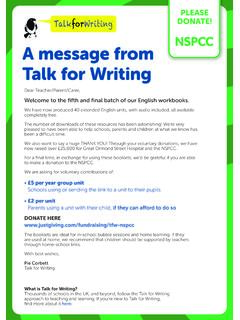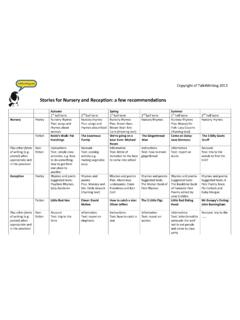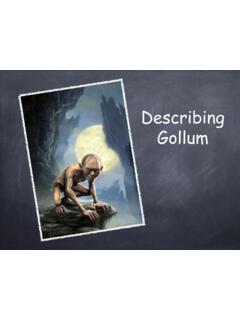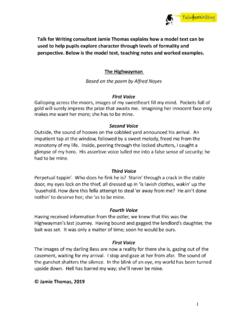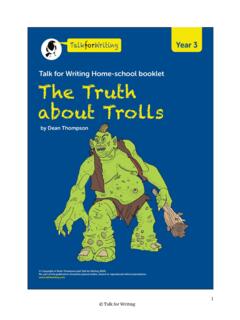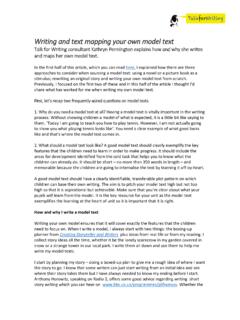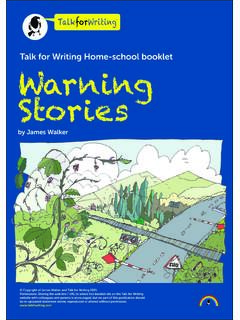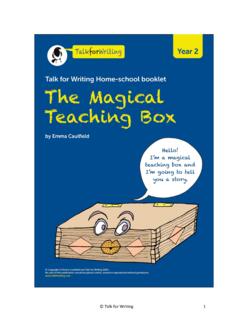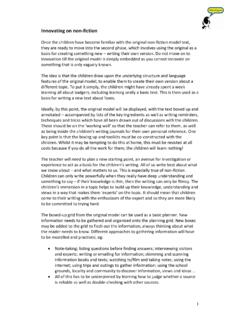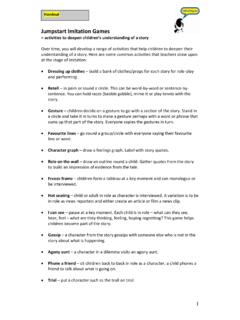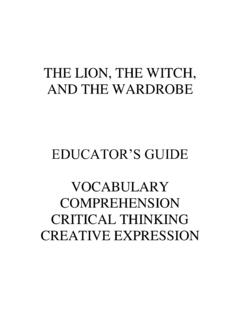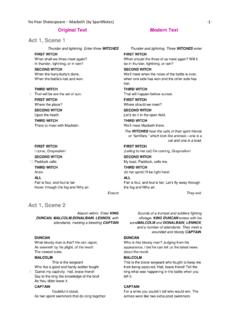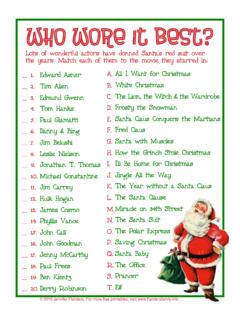Transcription of How would I use this book with TfW?
1 How would I use this book with TfW? Using model Texts by Kathryn Pennington As a trainer, I often get asked questions such as: How would I use this book with TfW? ; I am reading The Tunnel by Anthony Browne to my class how do I teach that using TfW? or Do you have a good model text for the Hobbit? Whether it s a picture book or a novel, it is important that during a TfW unit of work children have: 1. A good main model text which they can learn from. this model should include the key features and writerly tools that you want the children to learn, but also have a clearly transferable and identifiable pattern on which they can base their own writing. The model text should be no more than 350 words in length and it will be this text that the children learn off-by-heart. 2. Exposure, through shared reading, to other models and snippets collected from quality literature.
2 They can then add to their writer s toolkit by drawing upon what other authors do. So, I often go back and ask the teachers how do they want the book to be used? Using a novel or picture book as a stimulus One way is to use a novel or a picture book as a stimulus. If in class you were reading and studying the lion , the witch and The Wardrobe (TLTWTW) by Lewis, you may decide to teach the children how to write a portal story with a focus on writing a cracking setting. If this is the case, I would recommend using Pie s Elf Road as a model text as this is a great portal story into a fantasy world which incudes a carefully crafted setting. ( ) I would read TLTWTW to the class at the end of every school day and use carefully chosen extracts within my English lessons to read as a reader and read as a writer . We want children to comprehend what they read but also explore the writerly tools used and their effect on the reader.
3 An example would be to explore the snippet below with the children. It is the moment Edmund first sees the White witch s Castle: You could then add to the toolkit and learning by reading other snippets like this one. The novel becomes a stimulus. A rich resource to draw ideas and inspiration from, but ultimately, we are not asking our children to write the lion , the witch and the Wardrobe! If we are asking children to write a short portal story, then their main model needs to be a short portal story. The Learning Journey To summarise the learning journey: Outcome: Portal Story Focus: Setting Model text: Elf Road Supporting Literature: CLASS book : the lion , the witch and The Wardrobe (& 2+ other snippets). Similarly, Pie s Zelda Claw works well as a model when reading, Varjak Paw by S. F. Said. So again the learning journey could be: Outcome: Adventure / Quest story Focus: Suspense Model text: Zelda Claw Supporting Literature: CLASS book : Varjak Paw (& 2+ others snippets) It works for non-fiction too.
4 Pie s: Buy Now: Multifunction Mobile Phone and Buy Now: Multi-purpose Spy Key Ring, works alongside the Alex Rider series by Anthony Horowitz which can be found here: Here are some other suggestions: book Suggested Model Text written by Pie Corbett Squash and a squeeze by Julia Donaldson The Squeaky Story Rosie s Walk Charlie s Walk We re going on a bear hunt Take a Walk Little Bear How the Whale Became and other stories by Ted Hughes How the Tiger Learned Not to be Greedy & How the Tortoise got its Shell A Traveller in Time by Alison Utterly Back in time The Mozart Question (or WW2 themed book ) Gas Mask The Water Tower by Gary Crew Alien Landing Dead Man s Cove or Famous 5 Series Adventure at Sandy Cove Safia and the Captain Some picture books are fine to be used as a model text Farmer Duck because they follow the golden principles of being easy to innovate, filled with memorable, meaningful repetition and include the key language features/structures that you would want your children to internalise and learn.
5 Rewriting a model based on a book Trying to write a model text by rewriting or abridging an original comes with a warning no one does Philip Pullman like Phillip Pullman, but there are some, often traditional tales, which need rewriting to deliver exactly what you need almost to make them more teachable . Pie has rewritten many traditional tales to ensure that they include key language patterns, a clear structure and memorable meaningful repetition. We need to ensure that model texts teach children key, transferable language patterns that can be built upon year after year. Our aim is to create confident, imaginative and independent writers, so we need to ensure that the tools and models that we expose them to support them in this journey. More information and 15 example model texts can be found in Talk for Writing in the Early Years.
6 I have included two example models at the back of this article that are based on the following books: Lost and Found by Oliver Jeffers (model written by Cazz Williams, Y1 Literacy Lead at Warren Road) Mr Big by Ed Verr (written by me) An alternative idea is to take a model text (I always use Pie s) and adapt it so that it is based on the book . Have a look at Little Charlie and the Lighthouse Keeper model texts at the end of this article. this is actually Pie s story Little Charlie but adapted to run alongside the Lighthouse Keeper s Lunch. When I did this with some Year 2 teachers this story became our model, but every day we still planned to read the actual Light House Keeper s Lunch and explore it in depth. The model text is much easier for the children to learn and innovate upon. So, how would I use the Hobbit as a model text? When I m asked, How would I use the Hobbit as a model text?
7 I now reply, I wouldn t . Instead I would use The Hobbit as a stimulus but write or adapt my own model which has the underlying pattern of a quest / adventure story and includes similar characters goblins, trolls and elves. An example of this is Pie s opening chapter model text, which is in the style of The Hobbit and can be found in the Year 6 Writing Models book . 3 approaches to consider There are 3 approaches to consider when creating a model text: 1) Using a novel or a picture book as a stimulus 2) Rewriting an original story 3) Writing your own this article hasn t looked at this option. Writing your own is the most difficult option, but also the most rewarding. I ve written a separate article with advice on this that will be made available online and featured in the next term s TfW newsletter. Some final key points Having a model text is vitally important.
8 Without showing children a model of what is expected, it is a little bit like saying to them: Today I am going to teach you how to play tennis, but I m not actually going to show you what playing tennis looks like. Pitch your model texts high, make them aspirational but achievable and teach with high expectations. Make sure that teachers are looking critically at their models and thinking what will my children learn from this model and add to their writer s toolkit belt? Although creating and/or finding the right model text can take time, once done, you will always have it. Collect a bank of model texts and use them year on year just tweak them to meet the needs of your new class. Kathryn is a former Assistant Head of a large primary school in Northamptonshire, where she successfully led the Talk for Writing approach and worked as a Lead Literacy Teacher, Advanced Skills Teacher and a Specialist Leader of Education.
9 Kathryn provides Talk for Writing training throughout the UK. Web: Email: Model Texts included below 1) Zelda Claw by Pie Corbett 2) Lost and Found by Cazz Williams, Y1 Literacy Lead at Warren Road School 3) Mr Big by Kathryn Pennington 4) Little Charlie and the Lighthouse Keeper written by Pie Corbett, adapted by Kathryn Pennington & Y2 teachers at St Andrews Primary School Zelda Claw and the Rain Cat All night, thunder growled overhead. Zelda crouched in the darkness, staring. Wind lashed the glistening tarmac and the streetlights flickered; Zelda shivered. Where could she escape from the rain? At that moment, Zelda heard something crawling along the pavement, hidden by shadows. A vague shape slipped into a doorway. A green eye flickered. Zelda s fur prickled as she watched. What was it? Without thinking, Zelda dashed under a lorry and crouched as still as stone.
10 Silently, the shadow of an enormous cat paced through the darkness, sinking along the rain washed pavements. Zelda shivered. Slowly, the great rain cat drew closer and closer. Zelda could hear its claws scratching on the tarmac and see its green eyes glittering. Had it seen her? At that moment, Zelda could bear it no longer. Leaping out from under the lorry, she shot back across the rain-swept road and jumped over the wall. She was alone. The rain cat had not followed her. Zelda was safe for now. Pie Corbett 2012 Lost and Found Somewhere north of Italy there lived a boy. One cold, winter s day he found a penguin slumped at his door. The penguin looked sad and the boy was curious. He thought it might be lost. First, the boy decided to row the penguin to the South Pole. They rowed and they rowed and they rowed for many days and nights. A storm raged and they trembled with fear.
